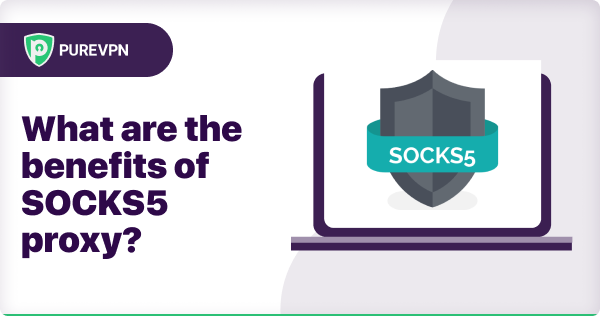Using a SOCKS5 proxy to route your traffic can improve your privacy, but it doesn’t ensure security. That’s because, contrary to a VPN, a SOCKS5 proxy doesn’t use encryption to safeguard your data.
In this blog, we will talk about what a SOCKS5 proxy is, the benefits it brings to the table, and how you can set one up. Let’s dive in:
What is a SOCKS5 proxy?
A SOCKS5 proxy is a VPN alternative that lets you browse privately and access censored or geo-restricted content. It uses proxy servers to route packets between a client and a server – this masks your real IP address and replaces it with another one given to you.
SOCKS5 proxies have three authentication methods, which make them more secure than traditional proxies. These include GSS-API authentication, null authentication, and username/password authentication.
When it comes to null authentication, you can connect to the proxy without any authentication. With username/password authentication, you need to enter private credentials to connect to the proxy. GSS-API authentication involves the server and you using authentication mechanisms at the operating system-level to confirm your identity.
How does a SOCKS5 proxy work?
When you use a SOCKS5 proxy, your traffic is transmitted through a proxy server – that assigns you a random IP address – before it reaches your intended destination. The latest version of SOCKS5 uses proxy servers to establish Transmission Control Protocol (TCP) or User Datagram Protocol (UDP) connections through random IP addresses.
Related Read: TCP vs UDP: What is the difference?
If your IP address is 1.2.3.4 and your traffic is sent through a SOCKS5 proxy whose IP address is 5.6.7.8, the website will see that the request originated from the proxy server. In other words, your actual IP address is hidden from the website. This helps you conceal your location, but your traffic is still unprotected.
Unlike a VPN, a SOCKS5 proxy (or any proxy, really) doesn’t encrypt your traffic – it’s out in the clear for anybody to see what you are doing online!
What are the advantages of using a SOCKS5 proxy?
Here are some benefits of a SOCKS5 proxy:
Helps you bypass internet blocks
Since proxies act as middlemen between your device and the internet, they can enable you to get around internet blocks quite easily.
For instance, if a certain website or service blacklists your real IP address (or you use a VPN with blacklisted server IPs), you can send your traffic through a SOCKS5 proxy to circumvent this block.
However, a SOCKS5 proxy won’t be able to help you bypass national firewalls like a VPN does, as they often use deep packet inspection (DPI) technology.
Gives you a faster connection
A SOCKS5 proxy (unlike its predecessors) can use UDP, which guarantees efficient performance.
TCP creates a connection between a client and a server, ensuring all packets reach from one side to the other. One the other hand, UDP doesn’t focus on if all packets from the server or client make it to the other side and whether they are sent in the same order.
Therefore, with its support for UDP, a SOCKS5 proxy is able to offer faster speeds.
Fewer errors = better overall performance
Contrary to other proxies, a SOCKS5 proxy doesn’t rewrite data packet headers, reducing the risk of mislabeling or misrouting that data. With far fewer errors occurring, the performance improves automatically.
That said, the increased performance comes at the expense of your security and privacy, as packet headers have your personal information and can be identified easily.
Offers faster P2P downloads
Given that it transfers fewer data packets, a SOCKS5 proxy is faster than other types of proxies. This results in faster download speeds, due to which many users use SOCKS5 proxy servers for P2P file sharing and torrenting.

How can I set up a SOCKS5 proxy on Windows?
Just follow these steps to set up a SOCKS5 proxy on Windows:
- Open Settings.
- Click Network & internet.
- Select Proxy.
- Under the Manual proxy setup section, go to Set Up.
- Toggle on the Use a proxy server option.
- Enter the information about your proxy server.
- Click the Save button.
You are good to go!
How can I set up a SOCKS5 proxy on macOS?
Just follow these steps to set up a SOCKS5 proxy on macOS:
- Open System Preferences.
- Click Network.
- Select Advanced.
- Go to the Proxies tab.
- Under Select a protocol to configure, choose SOCKS5.
- Enter your proxy server address.
- Click the OK button.
You are all set!
Is a SOCKS5 proxy better than a VPN?
A SOCKS5 proxy isn’t as fast and secure as a VPN. It’s easy to mix up the two tools, but there are significant differences between them. Like other proxies, a SOCKS5 proxy won’t use encryption on your data and will reduce internet stability and speed.
However, a good VPN service like PueVPN encrypts your data as it goes from your device to the VPN server, making sure that it can’t be viewed at any stage along the way. It will let you access unavailable content from anywhere with excellent privacy and security and at super-fast speeds.
Frequently asked questions
What is a SOCKS5 VPN?
A SOCKS5 VPN is a Virtual Private Network service that supports SOCKS5 – the protocol commonly used for proxy connections. Using a SOCKS5 VPN, you can route your traffic through a SOCKS5 proxy server operated by the VPN service, which acts as an intermediary between your device and the internet.
Can I use a free SOCKS5 VPN?
Currently, there are no free VPNs that offer a SOCKS5 proxy. You should avoid using free VPNs in general. Research has revealed that free VPN services often engage in practices such as collecting user data, profiling users, and selling their data to third parties.
Furthermore, studies have uncovered instances where free VPNs misrepresent the level of encryption they provide, experience data leaks and app vulnerabilities, and even include spyware in their software or apps.
These factors make the use of free VPNs highly risky. If you care about your online privacy and security, you are better off sticking to premium VPNs that offer a much more reliable service for a fairly decent price.
What’s the difference between a SOCKS5 proxy and HTTP proxy?
HTTP proxies only work with HTTP and HTTPS web pages, whereas SOCKS5 proxies work with any sort of traffic
An HTTP proxy is a high-level proxy typically designed for a single protocol. Though this means you experience better connection speeds, it’s not as secure and flexible as a SOCKS5 proxy, which is a low-level proxy capable of handling any protocol and traffic.
Can I get a SOCKS5 proxy for free?
Yes, but using a free SOCKS5 proxy has some serious downsides. They often have poor infrastructure and fewer configuration options, making them less secure and slower to use. Furthermore, if you’re getting something for free, you’re the product! Free SOCKS5 proxies can monitor your traffic and sell it to third parties for a profit. Due to this, your best bet is to use a premium proxy or VPN.
Does PureVPN offer a SOCKS5 proxy?
No. PureVPN currently doesn’t offer SOCKS5 proxy connections.
Final word
Have any other questions about SOCKS5 proxies? Let us know in the comments section below, and we’ll get back to you as soon as we can!



